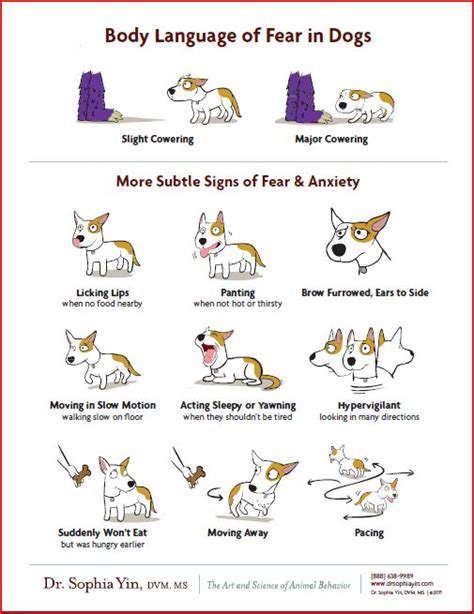How to recognize signs of stress in your dog

Understanding Canine Body Language
Dogs communicate volumes without uttering a single bark. Their bodies tell stories through subtle shifts in posture, fleeting facial expressions, and the eloquent dance of their tails. Mastering this silent language unlocks the door to their emotional world, enabling early detection of distress before it escalates into more serious issues. Each canine companion speaks this language with unique dialects - what signals anxiety in one might simply indicate curiosity in another. This individuality makes attentive observation of your dog's normal behavior patterns absolutely vital.
Watch for telltale physical changes like tails retreating between hind legs or ears plastering flat against the skull. Such physical manifestations often serve as the first whispers of discomfort. Developing fluency in interpreting these subtle cues forms the foundation of proactive canine stress management.
Identifying Vocalizations
The canine vocal repertoire extends far beyond simple barks. Our four-legged friends express themselves through a symphony of sounds - from plaintive whines to rumbling growls, each carrying distinct emotional weight. That high-pitched whimper might reveal hidden anxiety, while a throaty growl could signal growing unease. Learning to distinguish these auditory clues helps gauge emotional temperature and respond appropriately to your companion's needs.
Assessing Tail Wagging
Contrary to popular belief, tail movements don't always signify joy. That stiff, robotic wag or unnaturally elevated tail often broadcasts tension. The sudden silencing of a wagging tail or abrupt changes in its rhythm can scream stress louder than any bark. Context remains king when interpreting tail language - consider the whole body picture and environmental factors before drawing conclusions.
Tail telegraphy involves complex variations - rapid, choppy motions may betray nervous energy, while languid sweeps could indicate cautious optimism. Noticing subtle shifts in these patterns provides critical insights into your dog's emotional landscape.
Recognizing Changes in Eating and Elimination Habits
Appetite and elimination patterns serve as barometers of canine wellbeing. Stress might manifest as sudden food aversion or peculiar pickiness. Conversely, some anxious dogs experience increased urinary frequency or digestive upset. These biological responses often fly under the radar yet provide some of the most reliable stress indicators when monitored consistently over time. Establishing baseline norms makes deviations more noticeable.
Environmental Factors and Triggers
Canine stress often roots in environmental disturbances - disrupted routines, unfamiliar faces, jarring noises, or strange settings. Anticipating and mitigating these stressors can dramatically improve your dog's quality of life. Consistency and predictability form the bedrock of canine security, transforming chaotic environments into comforting spaces.
Behavioral Changes: Clues from Your Dog's Actions
Decoding Canine Body Language
Dogs broadcast their emotional state through constant physical telegraphy, despite attempts to appear stoic. Learning this visual vocabulary provides unparalleled insight into their wellbeing. That typically sociable pup who suddenly becomes a shrinking violet, tail tucked and ears flattened, clearly signals something amiss in their world.
Changes in Eating Habits
Dramatic appetite fluctuations often serve as red flags for underlying stress. The food-motivated dog turning up its nose at meals or the dainty eater suddenly gorging both warrant attention. These changes rarely occur in isolation - accompanying symptoms help complete the diagnostic picture.
Changes in Elimination Habits
Stress frequently manifests in bathroom behaviors. Some dogs urinate more frequently when anxious, others may struggle to relieve themselves entirely. While medical causes should always be ruled out first, these patterns often reflect emotional turmoil requiring compassionate intervention.
Changes in Sleep Patterns
Sleep disturbances provide another window into canine stress. Excessive drowsiness or restless nights both suggest something disrupts your dog's equilibrium. Contextual clues help determine whether environmental factors or deeper issues drive these changes.
Changes in Play Behavior
The playful pup turned couch potato or the gentle giant turned roughhouser both tell important stories. Tracking these behavioral shifts helps identify stressors and modify interactions accordingly.
Changes in Vocalizations
Sound patterns evolve with emotional states. The normally quiet companion developing a penchant for mournful howls or the chatty dog falling uncharacteristically silent both communicate distress through their changed voices.
Seeking Professional Help
When behavioral changes persist or intensify, professional guidance becomes essential. Veterinarians and animal behaviorists possess the expertise to distinguish medical issues from purely behavioral ones, crafting tailored solutions to restore canine happiness.

Environmental Factors: Identifying Potential Stressors
Identifying Environmental Stressors in Plants
Plant health mirrors environmental conditions with remarkable accuracy. Stress signals range from barely perceptible pigment changes to dramatic wilting episodes. Early detection of these botanical distress calls allows for timely intervention, preventing minor issues from blossoming into major problems.
Temperature Fluctuations and Their Impact
Plants possess distinct thermal comfort zones. Prolonged exposure outside these ranges triggers stress responses. The speed of temperature change proves equally important - gradual shifts allow for adaptation while sudden swings shock plant systems.
Light Intensity and Photoperiod
Light serves as botanical lifeblood, yet requirements vary dramatically between species. The delicate balance between too little and too much light determines whether plants thrive or merely survive. Observing leaf responses provides the best guide for optimal placement.
Water Availability and Soil Moisture
The hydration tightrope walk challenges every gardener. Plants protest both drought and waterlogging through visible symptoms. Understanding species-specific needs and soil characteristics helps maintain that perfect moisture equilibrium.
Nutrient Deficiencies and Soil Conditions
Soil serves as a nutritional buffet, and missing menu items manifest in plant appearance. Yellowing leaves might signal nitrogen hunger while stunted growth could indicate phosphorus deficiency. Regular soil testing prevents these dietary shortfalls.
Air Quality and Pollution
Invisible atmospheric invaders wreak havoc on plant health. Urban environments particularly challenge vegetation with complex pollutant cocktails. Selecting hardy varieties or implementing protective measures helps plants weather these assaults.
Seeking Professional Help: When to Consult a Veterinarian

Seeking Support for Mental Well-being
Modern life's complexities sometimes overwhelm our coping capacities. Acknowledging this struggle represents the critical first step toward healing. When emotional burdens persist or intensify, professional support offers clarity amidst the chaos. Therapists provide judgement-free spaces to unpack emotional baggage while equipping clients with practical coping toolkits.
Identifying Signs of Need for Professional Intervention
Persistent emotional disturbances that disrupt daily functioning clearly signal the need for professional support. Withdrawal from social connections, cognitive fog, or radical sleep and appetite changes all warrant serious attention. These symptoms represent the psyche's distress flares - ignoring them risks emotional decompensation.
Understanding the Benefits of Professional Guidance
Therapeutic relationships offer more than symptom relief - they facilitate profound self-discovery. Speaking one's truth in a supportive environment fosters remarkable healing and growth. Therapists help clients identify behavioral patterns, develop healthier coping mechanisms, and build emotional resilience for life's inevitable challenges.
- The Benefits of Daily Mindfulness Practice for Stress Relief
- Enhancing Mental Well being Through Daily Practices
- Caring for your aging dog’s teeth and gums
- Calming products to help anxious dogs relax
- How to improve the life of a senior dog
- How to spot signs of pregnancy in your dog
- How to choose the right harness for your dog
- How to build trust with a rescue dog
- How to house train a rescue dog quickly
- How to organize a balanced meal plan for your dog
- The best portable dog bowls for travel and hiking
- The top rated dog travel crates for every budget